Products Category
- FM Transmitter
- 0-50w 50w-1000w 2kw-10kw 10kw+
- TV Transmitter
- 0-50w 50-1kw 2kw-10kw
- FM Antenna
- TV Antenna
- Antenna Accessory
- Cable Connector Power Splitter Dummy Load
- RF Transistor
- Power Supply
- Audio Equipments
- DTV Front End Equipment
- Link System
- STL system Microwave Link system
- FM Radio
- Power Meter
- Other Products
- Special for Coronavirus
Products Tags
Fmuser Sites
- es.fmuser.net
- it.fmuser.net
- fr.fmuser.net
- de.fmuser.net
- af.fmuser.net ->Afrikaans
- sq.fmuser.net ->Albanian
- ar.fmuser.net ->Arabic
- hy.fmuser.net ->Armenian
- az.fmuser.net ->Azerbaijani
- eu.fmuser.net ->Basque
- be.fmuser.net ->Belarusian
- bg.fmuser.net ->Bulgarian
- ca.fmuser.net ->Catalan
- zh-CN.fmuser.net ->Chinese (Simplified)
- zh-TW.fmuser.net ->Chinese (Traditional)
- hr.fmuser.net ->Croatian
- cs.fmuser.net ->Czech
- da.fmuser.net ->Danish
- nl.fmuser.net ->Dutch
- et.fmuser.net ->Estonian
- tl.fmuser.net ->Filipino
- fi.fmuser.net ->Finnish
- fr.fmuser.net ->French
- gl.fmuser.net ->Galician
- ka.fmuser.net ->Georgian
- de.fmuser.net ->German
- el.fmuser.net ->Greek
- ht.fmuser.net ->Haitian Creole
- iw.fmuser.net ->Hebrew
- hi.fmuser.net ->Hindi
- hu.fmuser.net ->Hungarian
- is.fmuser.net ->Icelandic
- id.fmuser.net ->Indonesian
- ga.fmuser.net ->Irish
- it.fmuser.net ->Italian
- ja.fmuser.net ->Japanese
- ko.fmuser.net ->Korean
- lv.fmuser.net ->Latvian
- lt.fmuser.net ->Lithuanian
- mk.fmuser.net ->Macedonian
- ms.fmuser.net ->Malay
- mt.fmuser.net ->Maltese
- no.fmuser.net ->Norwegian
- fa.fmuser.net ->Persian
- pl.fmuser.net ->Polish
- pt.fmuser.net ->Portuguese
- ro.fmuser.net ->Romanian
- ru.fmuser.net ->Russian
- sr.fmuser.net ->Serbian
- sk.fmuser.net ->Slovak
- sl.fmuser.net ->Slovenian
- es.fmuser.net ->Spanish
- sw.fmuser.net ->Swahili
- sv.fmuser.net ->Swedish
- th.fmuser.net ->Thai
- tr.fmuser.net ->Turkish
- uk.fmuser.net ->Ukrainian
- ur.fmuser.net ->Urdu
- vi.fmuser.net ->Vietnamese
- cy.fmuser.net ->Welsh
- yi.fmuser.net ->Yiddish
A Look at the Studer OnAir 2500 Modulo
While Studer's range of digital broadcast consoles have proved popular in Europe and the Far East, the firm's visibility within North America, in the main, has been limited to larger TV and video production facilities.
John Hart, national sales director for Studer-Soundcraft, said Studer has more than 60 large-scale live production consoles in the TV broadcast market handling some of the largest live events and music tours, and he said "good local U.S. technical support" has helped the company grow its U.S. business of late. "The success or failure of European products in the U.S. is directly related to strength, commitment and availability of the technical support organization in place to provide U.S. broadcasters a level of comfort."

Modulo 2500 12-Channel
Studer has introduced the OnAir 2500 Modulo, a spin-off of the OnAir 2500 digital console. The company markets it as a feature-heavy, networkable board with a simple user interface at a competitive price.
Building the mixer
The OnAir 2500 Modulo is a "build-a-mixer" version of the 2500, now available as separate fader blocks and a central control section, as opposed to being packaged in a standalone, tabletop configuration.
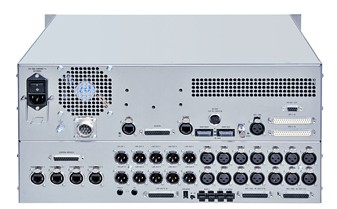
Backplane of the Rackmounted Mainframe Input/Output and Processor Box
The 2500 Modulo ships with six mic and four stereo line-level analog inputs, eight stereo AES/EBU format inputs with sample rate conversion, plus ADAT inputs for studio monitoring and FireWire/MADI for more complex installations. Outputs comprise four stereo line-level XLR and D-sub ports, ports for control room monitoring and DJ/guest headphones, plus ADAT, FireWire and MADI connections.
Remote mic and line-level connections also can be handled via Studer's D21m I/O stagebox systems and multichannel MADI links, while multiple OnAir 2500 consoles in a studio complex can be connected via a Studer ReLink I/O sharing system, which provides access to shared I/O capacities.
In this way up to 56 inputs and 40 outputs can be accessed from an OnAir 2500 control surface. The 2500's engine can run at 44.1 kHz or 48 kHz sample frequencies, with synchronization to an internal or external word clock.
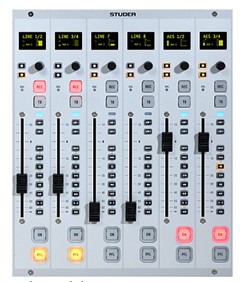
Fader Module
Like the OnAir 2000 and 3000 consoles from which this version is derived, the 2500 Modulo uses Studer's proven software technology but with a simpler user interface.
To reduce end-user prices, three standard configurations are available, equipped with a user-choice of 12, 18 or 24 assignable level faders; servo-controlled, motorized faders can be supplied as a system option. In addition to a level fader, each channel strip features a minimum of buttons and a single assignable rotary control, for a clear, uncluttered layout. The master section controls monitoring functions and source selection, while four assignable controls on the TFT screen are remapped as EQ and dynamics controls according to the user function selected locally or globally onto the target channel strips.
Channel strips
The remappable channel rotary control features a companion OLED screen that displays a channel label, a level and gain-reduction meter with parameter readouts that are accessible using two pushbuttons below the screen.
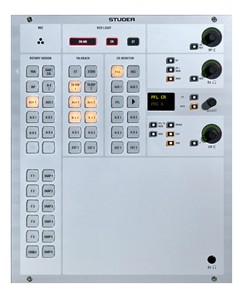
Master Module
For viewing system setups and channel settings in greater detail, the companion TFT touchscreen incorporates Studer's Touch'n'Action, for which only critical functions are assigned to hardware controls on the channel strip, further streamlining the console's operation.
Any console function — including dynamics, equalizer or aux send levels, for example — can be called to the TFT and adjusted either on a channel-by-channel basis or globally, with all parameter settings clearly and unambiguously displayed on the screen.
The control surface, at first glance, looks remarkably bare — possibly implying that the user will need to drill deep into the software to bring the required function to a knob, a fader or a button for adjustment; but this is not the case.
Important functions require a single command action, and are accessible virtually instantly, which is essential for a live air console where clear and unambiguous access to each control is important. Using the same symbolic language as Studer's Vistonics operating system, the 2500's user interface has been optimized as a flat hierarchy without the use of multilevel menus.
For phone-in and complex news operations, the OnAir 2500 integrates Studer's Call Management System/CMS, allowing caller names to be dynamically displayed as fader channel labels. For enhanced flexibility, existing radio automation systems can be integrated with one or more OnAir 2500 consoles using control protocol via conventional serial interface or TCP/IP networked connections. Control room monitoring can be selected between main stereo loudspeakers, PFL loudspeaker and headphone or guest headphone monitoring.
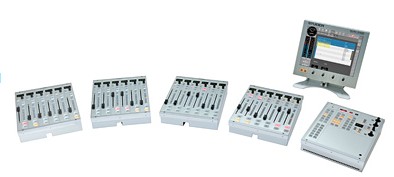
Modulo 2500 24-Channel
The Touch'n'Action user interface — used successfully in the 2000 and 3000 series consoles — provides control of channel functions via a row of direct-access buttons provided on each channel strip; pressing a key — Inputs, De-esser, EQ, Dynamics, Insert, Aux Send and Mix-Minus, plus two user-definable buttons — automatically opens the corresponding page view on the LCD's main screen.
Also provided are channel on/off and PFL buttons — the latter programmable to set up various groups for complex studio operations, for example — plus a dedicated record button that causes that channel output to start recording onto the dedicated buss, and a talkback key.
Central module
The OnAir 2500's central module comprises several primary sections: Rotary Assign, which assigns functions to the channel rotary encoders (pan, gain/calibration, source selection, mix-minus summing, aux send levels); talkback select; and monitoring selection with individual level controls for control room loudspeakers plus DJ and guest headphones.
Functions are soft and can be user programmed, if necessary. The array of user-defined keys usefully load any the six primary user-configuration snapshots, as well as five assignable functions such as I/O patch selections. A "Red Light" warning section features a trio of indicators for on-air warning, an open CR microphone or a live studio microphone; functions can be remoted to larger indicator panels, of necessary.
An optional studio monitoring and talkback panel provides remote red light operation, together with studio loudspeaker and headphone control, plus talkback to control room or other destinations, including mix-minus returns. - See more at: http://www.radioworld.com/article/a-look-at-the-studer-onair-2500-modulo/2393#sthash.zej8qIYA.dpuf
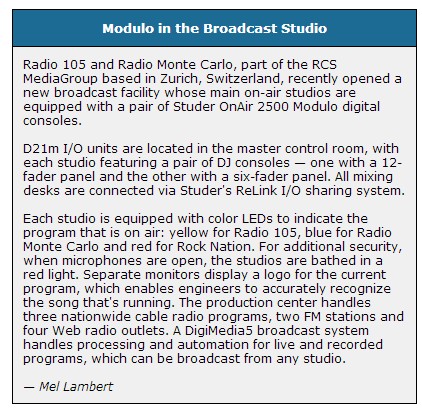
The Studer OnAir 2500 Modulo on-air and production console seems a well considered alternative to its all-in-one version for facilities that need the flexibility of multiple fader panels mounted into custom furniture, for example, or those requiring interlinked functions within a multiple-studio broadcast facility. It may also help the company find more of a foothold in the U.S. radio market.
Product Manager Axel Kern said the target market includes stations as well radio/TV networks. "Example applications for this console are mobile broadcasting, either live-to-air or production … In fixed installs, console features like I/O sharing and codec management support cost-effective architectures, using, for example, a few centralized codecs with a networked return line management instead of having multiple expensive codecs dedicated to each single console."
Kern noted that the U.S. radio broadcast market differs from the European in the number of commercial broadcasters.
"In most cases commercial stations have smaller budgets to spend and have to be operated much more cost effectively than, for example, a public broadcaster in Central Europe. … Modern digital broadcast consoles, especially in the radio market, must focus much more on supporting the user in an intuitive way, addressing him with a friendly and straightforward interface, both for operation and configuration." That, he said, has been Studer's goal. - See more at: http://www.radioworld.com/article/a-look-at-the-studer-onair-2500-modulo/2393#sthash.GTvRvtCe.dpuf





